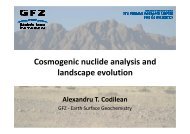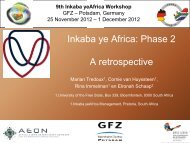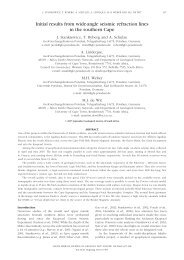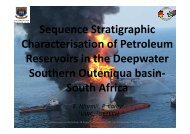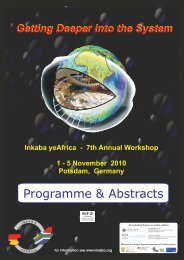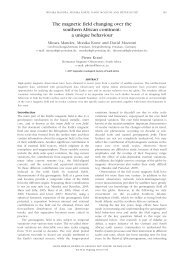South Africa - Inkaba.org
South Africa - Inkaba.org
South Africa - Inkaba.org
Create successful ePaper yourself
Turn your PDF publications into a flip-book with our unique Google optimized e-Paper software.
Towards a magmatic reaction model for iron-rich ultramafic<br />
pegmatites in the Rustenburg Layered Suite<br />
David L. Reid 1 , I. Veksler 2 , J. Jakobsen 3 , R. Trumbull 4<br />
1. Department of Geological Sciences, University of Cape Town, <strong>South</strong> <strong>Africa</strong>, david.reid@uct.ac.za<br />
2. GFZ German Research Centre for Geosciences, Potsdam, Germany, veksler@gfz-potsdam.de<br />
3. GFZ German Research Centre for Geosciences, Potsdam, Germany, jakob@gfz-potsdam.de<br />
4. GFZ German Research Centre for Geosciences, Potsdam, Germany, bobby@gfz-potsdam.de<br />
ABSTRACT<br />
Iron-rich ultramafic pegmatite (IRUP) occurs as irregular bodies replacing the layered sequence associated with the<br />
Merensky Reef and has fascinated workers with their unusual mineralogy, geochemistry and morphology. A<br />
simple magmatic origin is precluded by the extreme iron-rich composition and the highly irregular morphology, the<br />
latter also being inconsistent with injection as a crystal mush. Most workers have proposed some sort of<br />
replacement origin, involving a ferrobasaltic melt reacting with cumulate assemblages to produce the range of<br />
lithologies present in the IRUP bodies (olivine - clinopyroxene ± plagioclase ± magnetite)<br />
Ferrobasaltic magmas are thought to be responsible for the Upper Zone of the Rustenburg Layered Suite and<br />
certain highly differentiated melt fractions are thought to have migrated to the Critical Zone, causing replacement<br />
and disruption of the Merensky Reef, the UG2 chromitite and elsewhere in the layered sequence exposed in the<br />
platinum mines. Liquid immiscibility in the ferrobasaltic system is known to result in separate ultraferrous and<br />
felsic melts, the former being perhaps capable of migrating through and reacting with country rock of variable<br />
compositions to produce IRUP assemblages. The main question has been the composition of this ultraferrous melt<br />
and recognition of its reaction products in the rock record.<br />
While it is possible to characterize the starting materials (pre-exisiting layers of plagioclase - orthopyroxene ±<br />
olivine ± chromite cumulates) and the final products (IRUP suite), the lack of recognisable introduced reactant<br />
preserved in exposures examined requires an inductive approach. The most common lithology in the layered series<br />
is norite (sensu lato) and shows transformation to a wehrlite, often with a transition zone of olivine-gabbro or<br />
troctolite.<br />
We are currently pursuing a mass balance approach to estimate the composition of the introduced ultraferrous melt<br />
(UFM) and the residual melt (RM) that would satisfy the reaction equation below:<br />
NORITE + UFM = OL-GABBRO + WEHRLITE + RM<br />
Other approaches involve trying to derive possible ultraferrous melt compositions from liquid immiscibility<br />
experiments, and studies of melt inclusions in suitable minerals.<br />
KEYWORDS: IRUP, Merensky Reef, magmas, ultraferrous, UFM, RM<br />
70



